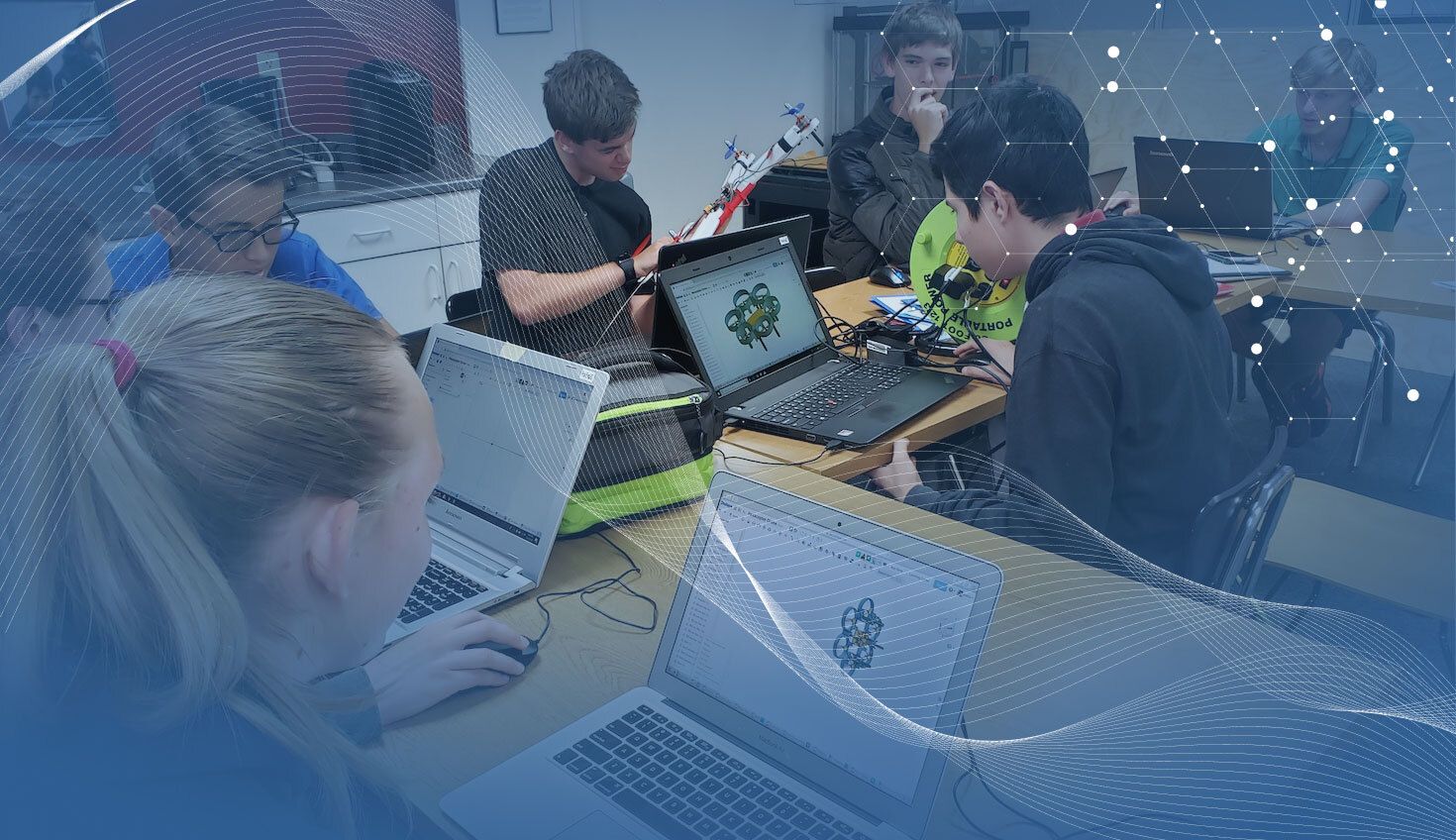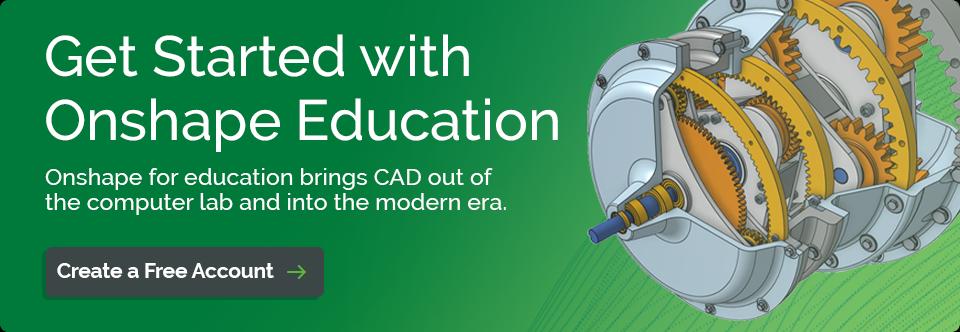
7:40
Professor Alison Olechowski runs the University of Toronto’s Ready Lab, a research team devoted to exploring “how engineering design teams can collaborate more efficiently and effectively using modern design tools.” The research team uses an interdisciplinary approach combining product development knowledge with concepts from psychology, software engineering and management science.
The Ready Lab’s findings are applied to engineering education, resulting in recommendations to improve STEM curricula in the classroom.
Professor Alison Olechowski shared her team’s research on cloud CAD collaboration at the 2021 PTC Digital Transformation in Education Summit.
Ongoing Ready Lab research aims to answer such questions as:
- What are the best practices for collaborating in modern computer-aided design (CAD)?
- Do effective engineering teams communicate differently than ineffective teams?
- How can teams reach reliable decisions when assessing new technologies?
- How can we improve productivity and attitude on distributed engineering teams while working from home?
Dr. Olechowski recently shared some of her team’s research in a presentation at the 2021 PTC Digital Transformation in Education Summit. In her talk, she outlined five reasons why she believes that cloud-based CAD is an absolute game-changer in design education. Here are her top five reasons:
1. Cloud CAD is More Online
Historically, CAD has not been an online activity. CAD software programs are typically tied to a local installation on a robust (usually expensive) computer. Even after the lengthy, IT-heavy installation process is complete, such programs often take time to load and/or update – sometimes up to several minutes.
What’s the big deal about a delay of a few minutes? Dr. Olechowski argues that it’s important to think about the technological and digital fluency of our students, who don’t know a world without the internet and who are increasingly accustomed to instant response and interaction online. Her university regularly offers STEM workshops to high school students from underrepresented populations to encourage their interest in STEM fields. She observes, “What I find really fascinating and positive is that these students, who’ve never seen a CAD software tool before, are so keen, and so unafraid of jumping right into Onshape… clicking around, making mistakes, learning the functionalities, and really having a lot of fun.”
“These students, all the time in their day-to-day lives, do things like record one-minute Tik Tok videos that they either put online or they scrap, they’re used to writing in Google Docs and seeing the texts that they write move around on a page, they’re used to building complex digital worlds in Minecraft,” Dr. Olechowski notes.
It’s not surprising that students take to cloud CAD so quickly because it’s very similar to the kinds of technologies they already use.
2. Cloud CAD is More Collaborative
Similar to Google Docs, cloud CAD allows students to work in the same CAD document at the same time, as opposed to traditional CAD data that lives on a single computer and can only be accessed by one person at a time. This capability allows students to develop the skills they will need to work in integrated, interdisciplinary teams, which is the reality of how work gets done in industry. Cloud-native CAD opens up new possibilities for how CAD is taught, such as peer learning and apprenticeship methods.
One component of Ready Lab’s research looks at how other fields have used collaborative technologies, such as paired programming in computer science, and explores how similar methods might be used when teaching CAD.
One study used Onshape as the cloud CAD platform on which designers could either work individually on a CAD challenge, work in parallel where two different users were at two different computers and manipulating the file at the same time, or a shared scenario in which two designers at two different computers shared one input. Designers were given a series of design tasks to complete and then the resulting CAD models were assessed for quality with a pre-determined rubric.
Initial findings indicated that while individual CAD designers may be faster at a per-person rate in completing the design tasks, the quality of the models tends to be higher when designers are working collaboratively. Additionally, the possibility of pairing students together for apprentice and peer-supported learning opportunities is more feasible with cloud CAD. Dr. Olechowski’s research is still in its early stages, but initial signs indicate that students’ designs improve when working collaboratively with each other and with their instructor, while also developing important skills in the process.
3. Cloud CAD is More Accessible
The accessibility of cloud CAD played out most poignantly during the 2020-2021 academic years as schools moved to remote instruction and STEM teachers scrambled to adjust. A universal challenge was finding ways to adapt face-to-face and often hands-on activities to an online modality. Many students were left with school-issued Chromebooks, on which cloud CAD platforms like Onshape were the only option for continued CAD learning.
Where previously students could only engage with CAD on an expensive computer in the classroom or computer lab, cloud-native design tools enabled access on Chromebooks or even on cell phones or tablets. Cloud CAD also levels the playing field for disadvantaged students who were historically excluded from participating in engineering courses because of limited resources or access.
But there is another common limitation in design education that is often overlooked. Dr. Olechowski refers to this phenomenon as the paradigm of “the CAD guy.”
As she describes it, “he’s the team member who early on decides to start the CAD model on his computer. And since the team is using traditional CAD software, the CAD guy becomes the owner of the CAD file and the gatekeeper of who gets access to the CAD file. He becomes, in a way, the hog of the CAD skill development, and sometimes also the cool part of the project he gets to monopolize, becoming the controller of the design, making important design decisions that should be collaborative.”
Cloud CAD flips this paradigm on its head, allowing for more than one person to access, view, and edit CAD documents at any time, essentially democratizing CAD. All team members have equal access, equal visibility and equal opportunity to contribute to the product design.
4. Cloud CAD is More Assessable
In addition to making it easier for students to access their design work, cloud-native CAD platforms also enable instructors to instantly access their students’ models and assemblies for the purpose of reviewing, assisting, and assessing their work. In the case of Onshape, the Education Enterprise plan allows instructors visibility into analytics of the students’ modeling behaviors, visualizing harder-to-see trends related to student learning trajectories.
Commenting on initial research conducted in the Ready Lab, Dr. Olechowski notes that “we need to collect more data, but we see that there may be signals in the CAD behavioral data that can tell us about the expertise and learning level of our students.”
Onshape’s audit trails, for example, allow instructors to see lists of all events happening on each specific document for a specific user in a specific timeframe. Is a student having trouble finishing a design assignment? The comprehensive Edit History in Onshape allows the instructor to see all of the student’s design activity in their design document and understand how much time they are spending in certain areas.
Additionally, dashboards that include data for the entire enterprise provide insights into the collective activity of a group of students. Perhaps the majority of students spent a noticeably longer period of time working on one particular aspect of a design, which could indicate that the instructor should make adjustments to the assignment itself, or include additional instruction to fill in the gaps where students are getting lost.
5. Cloud CAD is More Fun
As cloud-native CAD makes learning more online, more collaborative, and more accessible, it follows naturally that it opens new possibilities for design education to be more fun. As an example, Dr. Olechowski cites Illinois high school teacher Anthony Glorioso, who recently organized a game night for his students in which they recreated classic board games with Onshape.
Students simultaneously worked in the same CAD documents to design their own versions of games like Stratego, Rummikub, and Scrabble. But Dr. Olechowski says the point is less about the games they recreated, and more about the level of engagement generated by these types of early collaborative design activities: “New technology and new capabilities really do inspire us with new, creative ideas.”
Early research conducted by the Ready Lab team supports the “Cloud CAD is more fun” theory as well. The use of facial emotion recognition software to record designer emotions indicated high levels of emotion while designers worked on their designs in pairs, something that is only possible with cloud CAD. This research confirms the findings of paired programming – that working with someone else leads to higher emotion, and higher emotion can mean higher engagement and more fun.
Learn More About CAD Collaboration in the Classroom
To learn more about how cloud-native CAD can be a game-changer for both STEM educators and students, watch Dr. Olechowski’s full presentation at the PTC Digital Transformation in Education Summit.
(Find out how your K-12 school or university can benefit from switching to cloud CAD with an Onshape Education plan.)

Latest Content

- Case Study
- Industrial Equipment & Machine Design
Reframe Systems: Transforming Homebuilding with Digital Automation and Cloud-Native Onshape
09.25.2025 learn more
- Blog
- Becoming an Expert
- Assemblies
- Simulation
Mastering Kinematics: A Deeper Dive into Onshape Assemblies, Mates, and Simulation
12.11.2025 learn more
- Blog
- Evaluating Onshape
- Learning Center
AI in CAD: How Onshape Makes Intelligence Part of Your Daily Workflow
12.10.2025 learn more
- Blog
- Evaluating Onshape
- Assemblies
- Drawings
- Features
- Parts
- Sketches
- Branching & Merging
- Release Management
- Documents
- Collaboration
Onshape Explained: 17 Features That Define Cloud-Native CAD
12.05.2025 learn more



